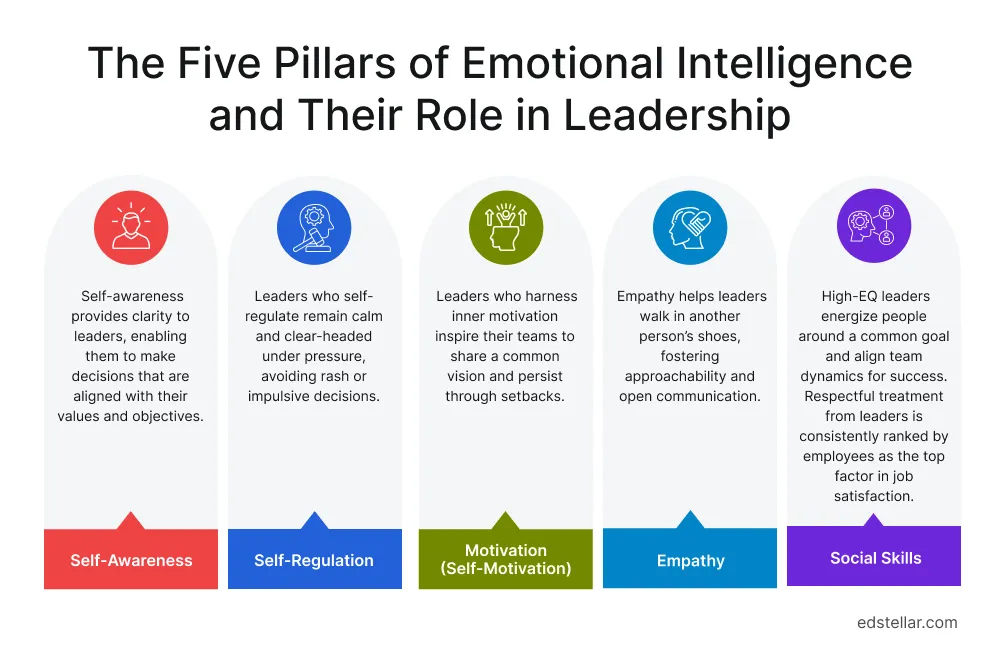
Emotional intelligence (EI) has always been a critical leadership trait, but in today’s rapidly evolving workplace, it has become more crucial than ever. The demands of a fast-changing, hybrid work environment, combined with the need for leaders to navigate complex, diverse teams, have amplified the importance of EI. Studies show EI is a top predictor of success: for example, TalentSmart reports that EI accounts for about 58% of job performance and that 90% of top performers are high in emotional intelligence.
Together, these findings underscore that technically smart companies also need emotionally smart leaders. Leaders who cultivate self-awareness and empathy outperform peers, driving innovation and employee engagement.
Meanwhile, the demands of a fast-changing, hybrid work environment have amplified the need for EI. Employees are now four times less likely to quit under managers with high EI, and organizations with emotionally intelligent cultures see higher productivity and customer loyalty. High performers tend to drive productivity, efficiency, and innovation, leading to improved business outcomes.
A Gallup survey found that poor managers who lack emotional intelligence create disengaged teams, leading to lower productivity, higher turnover, and reduced profitability. Leaders must encourage struggling managers to seek help and provide them with tailored coaching and support to improve people management skills.
Sustainable change requires understanding the root causes of disengagement and taking deliberate, localized actions to build a culture of engagement.
In short, leaders today succeed not just by what they know, but by how they connect. Prioritizing EI pays off in stronger morale, faster problem-solving, and greater agility during change, making emotional intelligence a must-have leadership skill.
Emotional Intelligence in Leadership – Why It Is Important Today
Global reports confirm that soft skills will dominate the future workplace. For example, the World Economic Forum’s Future of Jobs report lists empathy, social influence, resilience, and self-awareness among the top 10 core skills needed by 2030. In other words, high EQ is now as critical as technical ability for long-term success.
EI leaders build stronger teams: they earn trust, collaborate better, and motivate people to exceed targets. It boosts employee Engagement & Retention. Leaders who “lead with heart” keep people longer. Having an emotionally intelligent leader who fosters trust, communication, and support is a critical factor in retention. Prioritizing EI can dramatically boost engagement, saving time and costs in recruitment.
Further, EI is a key driver of workplace success, with individuals high in EI often ranking among top performers. These employees typically contribute to higher levels of productivity, operational efficiency, and creative problem-solving, all of which positively impact overall business results.
Leaders who demonstrate emotional intelligence excel in guiding teams through change, resolving conflicts constructively, and fostering a motivating environment, all of which enhance employee satisfaction and retention. Indeed, 71 percent of employers value EI more than technical skills when evaluating candidates.
What’s more? Emotional intelligence is especially vital in crises and change management. Managers rate EI as most important when leading teams through change, addressing personal issues, giving feedback, or spotting talent. In a Lee Hecht Harrison Penna survey of 500 people managers, a solid majority of respondents (57%) said that Emotional Quotient (EQ) is found in the highest-performing members of a team. Not surprisingly, 75% of respondents use EQ to determine promotions and salary increases.
Indeed, HBR’s EI Advantage survey (in partnership with Four Seasons) revealed that companies built on EI enjoy notably higher productivity and customer loyalty. It’s indeed a cornerstone of effective leadership, enabling leaders to build trust, manage conflict with empathy, and foster psychologically safe environments where employees feel valued and motivated.
Organizations that prioritize EI in leadership see stronger team engagement, lower turnover, and higher performance. Leaders with high EI connect authentically, adapt to change, and inspire innovation, driving not only employee satisfaction but also improved customer experiences and long-term business success.
In short, EI is no longer just “nice to have” – it’s a strategic necessity for navigating today’s challenges.
The Five Pillars of Emotional Intelligence and Their Role in Leadership
According to Daniel Goleman’s model, emotional intelligence breaks down into five core competencies, qualities that may seem soft but have hard, measurable impacts on performance. Each plays a specific role in leadership effectiveness:

1. Self-Awareness
Recognizing one’s own emotions and how they influence thoughts and actions. A self-aware leader knows their strengths and triggers, which builds authenticity and trust. As Goleman notes, people high in self-awareness are comfortable with their thoughts and emotions and understand how they impact others. This clarity helps leaders admit mistakes and make aligned decisions.
For example, a department head might notice tension building in themselves during a difficult meeting and choose to pause and reflect before reacting. This moment of self-awareness prevents an emotional outburst and models maturity. Leaders can develop self-awareness by journaling emotions, using mindfulness, and seeking 360-degree feedback. Indeed, leaders with high self-awareness are about 10% more effective in their roles than those who rank lower.
Reflecting on questions such as “What emotions show up most in my day?” or “How do my reactions affect my team?” can deepen this awareness. Being mindful of your inner state and how it influences your leadership decisions is the first step to building emotional intelligence.
2. Self-Regulation
Managing one’s impulses, stress, and moods. Leaders who self-regulate can stay calm and clear-headed under pressure, avoiding rash decisions. They consciously pause before reacting, as Goleman advises. Controlling impulses is crucial because acting rashly can damage relationships with clients or colleagues.
As one expert notes, leaders become emotional contagions, inflicting positive or negative feelings on others, underscoring why managing their own emotions and impulses is crucial to avoid negatively influencing their teams. Effective self-regulation means modeling composure for the team.
For instance, if a leader receives harsh criticism during a meeting, rather than becoming defensive or reactive, they might choose to acknowledge the comment and suggest continuing the conversation later. This shows maturity and control. Practicing self-regulation involves learning to pause, reframe negative thoughts, and stay grounded through techniques like deep breathing or focusing on personal values.
Asking yourself, “How do I typically respond under pressure?” or “What patterns do I notice in my emotional reactions?” builds insight. Over time, self-regulation allows leaders to remain composed, even in challenging environments, while encouraging the same resilience in their teams.
3. Motivation (Self-motivation)
Being driven by intrinsic goals, optimism, and passion. Emotionally intelligent leaders are self-motivated; they pursue success and improvement beyond external rewards. A passion for what you do fuels sustained effort and clear decision-making. 70% of employee engagement is attributable to the manager, underscoring how a leader’s motivation and optimism critically influence team commitment and productivity.
Leaders who harness inner motivation also inspire their teams to share a vision and persist through setbacks. A self-motivated leader might approach a failed project not with discouragement but with renewed focus, seeing it as a learning opportunity and encouraging the team to keep going.
Developing this kind of drive means setting meaningful goals, celebrating progress, and maintaining a growth mindset.
Leaders can stay energized by reflecting on what fuels their passion and asking themselves, “What drives me beyond recognition?” or “How do I handle setbacks without losing enthusiasm?” Deeply motivated leaders tend to lift those around them, infusing their teams with resilience, optimism, and a shared sense of purpose.
4. Empathy
Tuning into others’ emotions and perspectives. Empathy is perhaps the most well-known EI skill for leaders. Emotionally intelligent leaders can walk in another person’s shoes, understanding colleagues’ needs and concerns. This fosters approachability and open communication.
For example, a 2023 EY study reports that the majority (86%) of employees believe empathetic leadership boosts morale, while 87% say empathy is essential to fostering an inclusive environment, reflecting the powerful impact of empathy on workplace culture. Cultivating empathic leadership helps to navigate crises more effectively.
An empathic leader listens actively and responds to feelings, which builds engagement and a harmonious culture. Cultivating empathic leadership helps to navigate crises more effectively.
For example, when a team member’s performance declines, an empathic manager might check in personally and discover the issue stems from personal stress, allowing the leader to respond with flexibility rather than reprimand. Empathy is developed through active listening, reading nonverbal cues, and being genuinely curious about others’ experiences.
Leaders can practice asking questions like, “How can I support you?” or “What might this person be feeling right now?” True empathy also involves being present during conversations and demonstrating understanding, which makes people feel seen and valued.
5. Social Skills (Relationship Management)
Using empathy and awareness to communicate, influence, and resolve conflict. Leaders with strong social skills build rapport easily and lead teams collaboratively. Goleman calls this friendliness with a purpose. Such leaders communicate clearly, mentor others, and adeptly manage both conflict and collaboration.
As one analysis observes, high-EQ leaders energize people around a common goal and align team dynamics for success. Research shows that 72% of employees rate respectful treatment by leaders as the top factor in job satisfaction, highlighting the importance of leaders using their social skills to treat team members respectfully and inclusively.
Strong relationship management creates trust, fosters collaboration, and supports a thriving team culture.
For instance, a leader navigating a period of change might organize open forums for dialogue, acknowledging concerns while clearly articulating a shared vision. This approach builds trust and engagement.
Strong social skills are built through practicing open and respectful dialogue, improving non-verbal communication, and actively managing relationships. Leaders who reflect on questions like, “Do people feel heard when I speak?” or “How do I handle disagreements?” can gain insight into their relational habits. Ultimately, emotional intelligence in relationships creates trust, fosters collaboration, and supports a thriving team culture.
Ultimately, each pillar complements the others. For instance, self-awareness underlies empathy (how can you understand others if you don’t know yourself?), while motivation drives the perseverance needed to regulate emotions. Together, these EI dimensions enable leaders to stay resilient, inspire loyalty, and guide teams effectively.
A body of research confirms that emotionally intelligent leaders elevate individual behaviors and improve business results and team performance.
5 Real-World Examples of Emotional Intelligence in Leadership
While leadership styles vary widely, ranging from quiet, analytical decision-makers to bold, charismatic figures, what unites all highly effective leaders is a strong foundation in emotional intelligence. Whether guiding a merger that demands empathy and diplomacy or leading a turnaround that requires decisive authority, emotionally intelligent leaders adapt with insight because they understand the emotional dynamics at play.
EI in the workplace goes beyond simply managing emotions or being “nice.” It’s sine qua non for leadership. It means having the awareness to understand one’s drivers and triggers, the empathy to grasp others’ perspectives, and the social acumen to inspire, influence, and align teams toward shared goals.
These competencies directly contribute to improved collaboration, higher employee engagement, reduced conflict, and stronger organizational outcomes. Moreover, unlike innate personality traits, emotional intelligence can be developed through deliberate practice, feedback, and sustained commitment.
While building EQ takes time and effort, the payoff, for individual growth, team performance, and long-term business success, is well worth the investment.
The benefits of EI can be seen in how leading executives run their organizations. Here are five recent examples of corporate leaders demonstrating emotional intelligence:
- Satya Nadella (Microsoft): Since becoming CEO in 2014, Nadella has reshaped Microsoft’s culture by emphasizing empathy and growth. He famously said, “My personal philosophy and my passion … is to connect new ideas with a growing sense of empathy for other people.” Under his leadership, Microsoft’s internal collaboration increased (e.g., the company-wide hackathon), and employees report feeling empowered to innovate. Nadella’s approach, leading “with purpose and pride… not envy or combativeness,” is credited with rekindling employee engagement and driving Microsoft’s revival.
- Amazon: Amazon’s leadership culture is built on a foundation of customer obsession, ownership, and deep care for employees, codified in its 16 Leadership Principles that guide decision-making at every level. While customer focus is paramount, with leaders expected to start with the customer and work backwards, the company equally emphasizes the importance of its people.
The principle “Strive to be Earth’s Best Employer” explicitly directs leaders to foster a safer, more inclusive, and high-performing workplace, to lead with empathy, and to ask: “Are my employees growing? Are they empowered? Are they ready for what’s next?” This people-first mindset is reinforced by other principles such as “Hire and Develop the Best,” which mandates raising the performance bar with every hire and investing in employee development through programs like Career Choice, and “Learn and Be Curious,” which encourages continuous personal and professional growth.
Leaders are also expected to “Dive Deep” into operational details, listen to front-line feedback, and remove obstacles, ensuring employees have the tools and support to succeed. Practices like “Earn Trust” and “Have Backbone; Disagree and Commit” promote candid communication, psychological safety, and respectful challenge, creating a culture where employees feel heard and valued.
Together, these principles enable Amazon to scale globally while maintaining agility, innovation, and a high-performance culture rooted in accountability, empathy, and long-term thinking.
- Jack Ma (Alibaba): China’s tech billionaire Jack Ma routinely stresses the importance of EQ. He advises leaders that if a person wants to be successful, they should have a high EQ. Ma believes that humility and emotional learning are crucial: Alibaba’s employees are encouraged to learn from mistakes and to treat competitors and colleagues with respect. Even after stepping down as Alibaba’s chairman, Ma’s emphasis on purpose and “love quotient” (caring leadership) continues to influence Alibaba’s culture.
Indeed, with no shortage of supporting empirical evidence, individuals with high emotional intelligence (EQ) consistently demonstrate superior leadership abilities, build healthier and more collaborative relationships, and navigate stress and adversity with resilience and clarity. But the other two are also needed for optimal success.
- Mary Barra (General Motors CEO): Mary Barra exemplifies high emotional intelligence in her leadership, especially in moments of crisis. When GM confronted the ignition‑switch scandal in 2014, Barra responded with remarkable integrity and self‑awareness, publicly accepting accountability and launching one of the most comprehensive safety reviews in company history. This transparent approach transformed GM’s corporate culture, encouraging employees to speak up for safety, and also modeled composure and accountability under pressure, key aspects of self‑regulation and motivation.
Her leadership style is deeply people‑centric, grounded in empathy, trust, and authentic communication. From abolishing a 10‑page dress code in favor of dress appropriately, to cultivating genuine relationships by engaging with employees and their families, Barra’s actions foster psychological safety and trust, empowering teams to make decisions and innovate autonomously. She actively seeks feedback, supports diverse voices, and navigates cultural change with inclusive leadership, demonstrating robust social skills and emotional awareness throughout GM’s transformation into a tech‑forward and customer‑centric organization.
- Indra Nooyi (PepsiCo): The former PepsiCo CEO is known for her empathetic leadership advice. Nooyi famously recommends assuming positive intent when communicating with others. She explains that doing so raises your emotional quotient… because you are no longer random in your response. You don’t get defensive. You are trying to understand and listen. By role-modeling this mindset, Nooyi earned tremendous loyalty; for example, she would send handwritten notes to employees’ families. Her tenure at PepsiCo (and now as an Amazon board member) highlights how listening and caring boost engagement and performance.
These leaders show that EI is not about being soft on performance; it’s a different path to excellence. In each case, investing in understanding people led to innovation, lower turnover, and a stronger brand. As PepsiCo executive Nooyi advised, simply by assuming positive intent, you actively work to understand others.
This people-first mindset has translated into concrete business wins under each of the leaders above.
Top 5 Resources for Building Emotional Intelligence as a Leader
Leaders and HR professionals looking to develop EI can turn to a range of high-quality programs and materials. Below are five authoritative resources:
In addition to formal programs, leaders can develop EI through ongoing practices and tools: self-assessments (EQ-i, MSCEIT), coaching, 360° feedback, and popular literature (e.g., Daniel Goleman’s books or the HBR Emotional Intelligence Series). Corporate learning platforms like LinkedIn Learning or edX also offer EI courses.
Importantly, organizations can embed EI development in leadership pipelines: for example, incorporating EI 360-feedback in talent reviews or offering mindfulness and empathy workshops. The key is to blend training resources (like those above) with hands-on practice (e.g., mentoring, role-playing exercises).
For instance, Edstellar’s training and similar workshops provide structured modules, but leaders should also practice new skills daily (active listening, journaling emotions, etc.).
Ultimately, building EI is an evidence-based process. As one HBR analysis warns, firms that ignore EI training risk low productivity, stunted innovation, and an uninspired workforce.
By leveraging top-tier sources (Harvard, professional/corporate certifiers, thought leadership) and making EI development a priority, leaders and HR teams can foster the emotional competencies needed for high performance.
Conclusion
In summary, emotional intelligence is critical for effective leadership in the modern era. The evidence is clear: emotionally intelligent leaders drive better business outcomes, retain talent, and adapt more effectively to change.
As one comprehensive review puts it, emotionally intelligent leaders improve both behaviors and business results. We have seen how figures like Satya Nadella and Indra Nooyi use EI to transform their organizations, and how research from Harvard, the World Economic Forum, and others charts the path forward.
For HR professionals and corporate leaders, the challenge is twofold: measure EI in your teams, and then develop it. Fortunately, there are proven programs and tools to help build these skills, including Edstellar, a one-stop, instructor-led corporate training and coaching solution that addresses organizational upskilling and talent transformation needs globally.
Edstellar offers 2,000+ tailored programs across key disciplines such as Technical, Behavioral, Management, Compliance, Leadership, and Social Impact, enabling organizations to embed emotional intelligence at every level. With its robust Skill Management Software and dynamic Skill Matrix, Edstellar empowers L&D teams to assess, plan, and deliver high-impact training at scale. Whether through live virtual workshops or on-site coaching, Edstellar ensures that leadership development is not just theoretical, but practical, measurable, and aligned with strategic goals.
Furthermore, simple practices, giving empathetic feedback, practicing self-reflection, and assuming positive intent, can be woven into daily routines. By prioritizing emotional intelligence through platforms like Edstellar, organizations empower leaders to engage their people more deeply, foster inclusive cultures, and meet evolving strategic challenges with resilience and clarity.
In the words of Jeff Weiner, compassionate leadership isn’t just “nice”; it’s smart business. And with the right tools and partners, it’s also scalable, sustainable, and transformative.
Schedule a Demo to see how Edstellar can help your organization build emotionally intelligent leadership for the future.
Explore High-impact instructor-led training for your teams.
#On-site #Virtual #GroupTraining #Customized

Bridge the Gap Between Learning & Performance
Turn Your Training Programs Into Revenue Drivers.
Schedule a ConsultationEdstellar Training Catalog
Explore 2000+ industry ready instructor-led training programs.

Coaching that Unlocks Potential
Create dynamic leaders and cohesive teams. Learn more now!


Want to evaluate your team’s skill gaps?
Do a quick Skill gap analysis with Edstellar’s Free Skill Matrix tool

Transform Your L&D Strategy Today
Unlock premium resources, tools, and frameworks designed for HR and learning professionals. Our L&D Hub gives you everything needed to elevate your organization's training approach.
Access L&D Hub Resources.svg)
.svg)



.svg)


.svg)
.svg)
.svg)
.svg)

